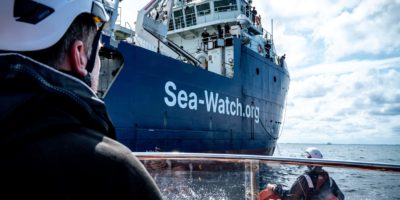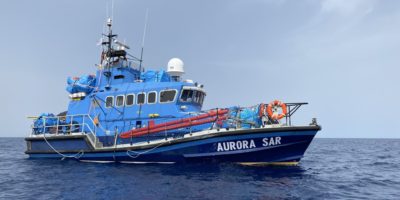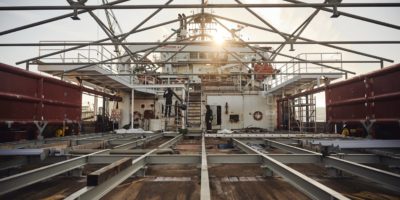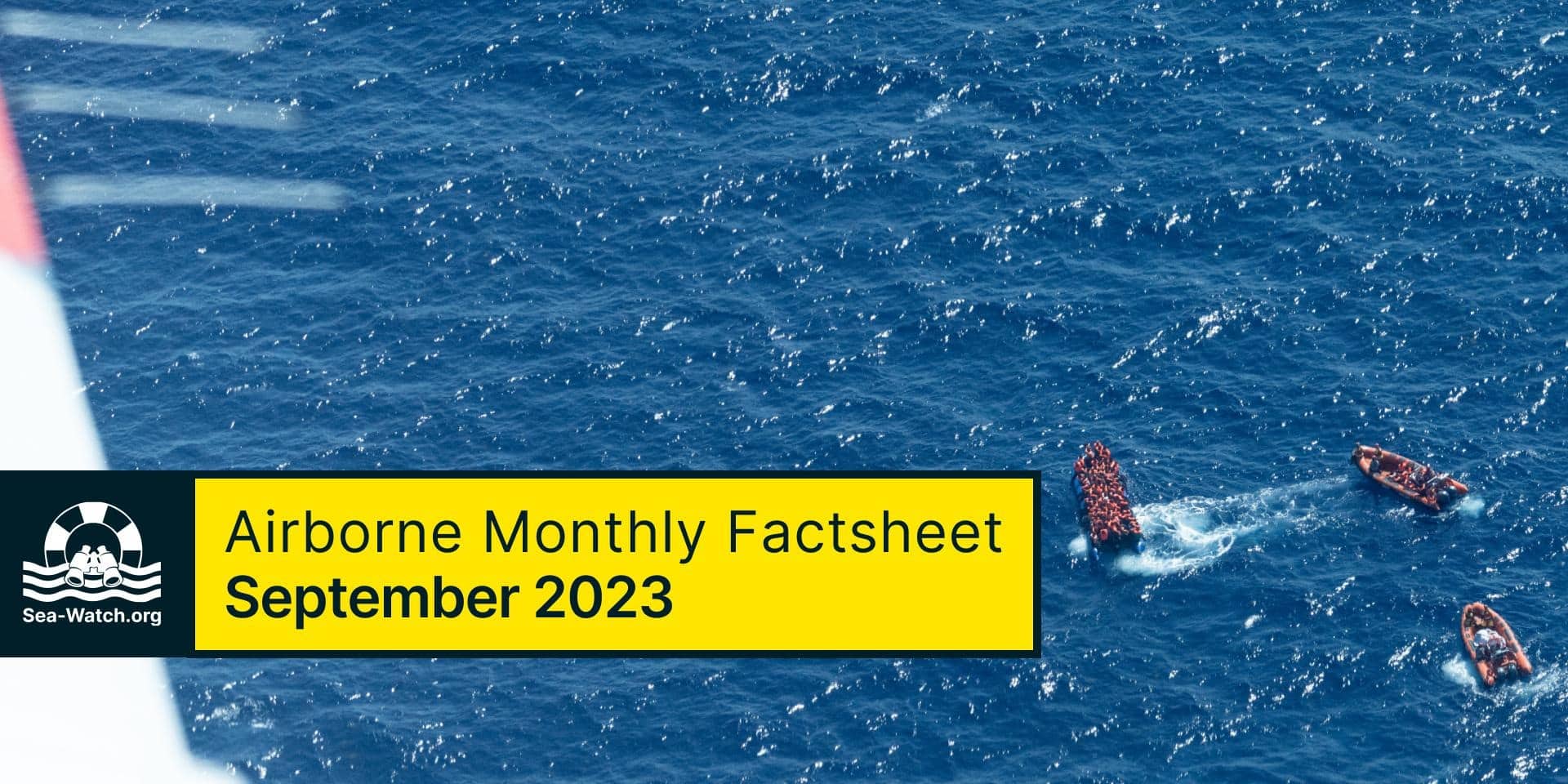This factsheet presents a summary of the distress cases witnessed in September 2023 by Sea-Watch’s Airborne Operations with the aircraft Seabird 2 (1). In September 2023, we conducted 10 operations over a total flight time of 61 hours and 02 minutes. We spotted 13 boats, carrying around 793 persons in distress at sea (2).
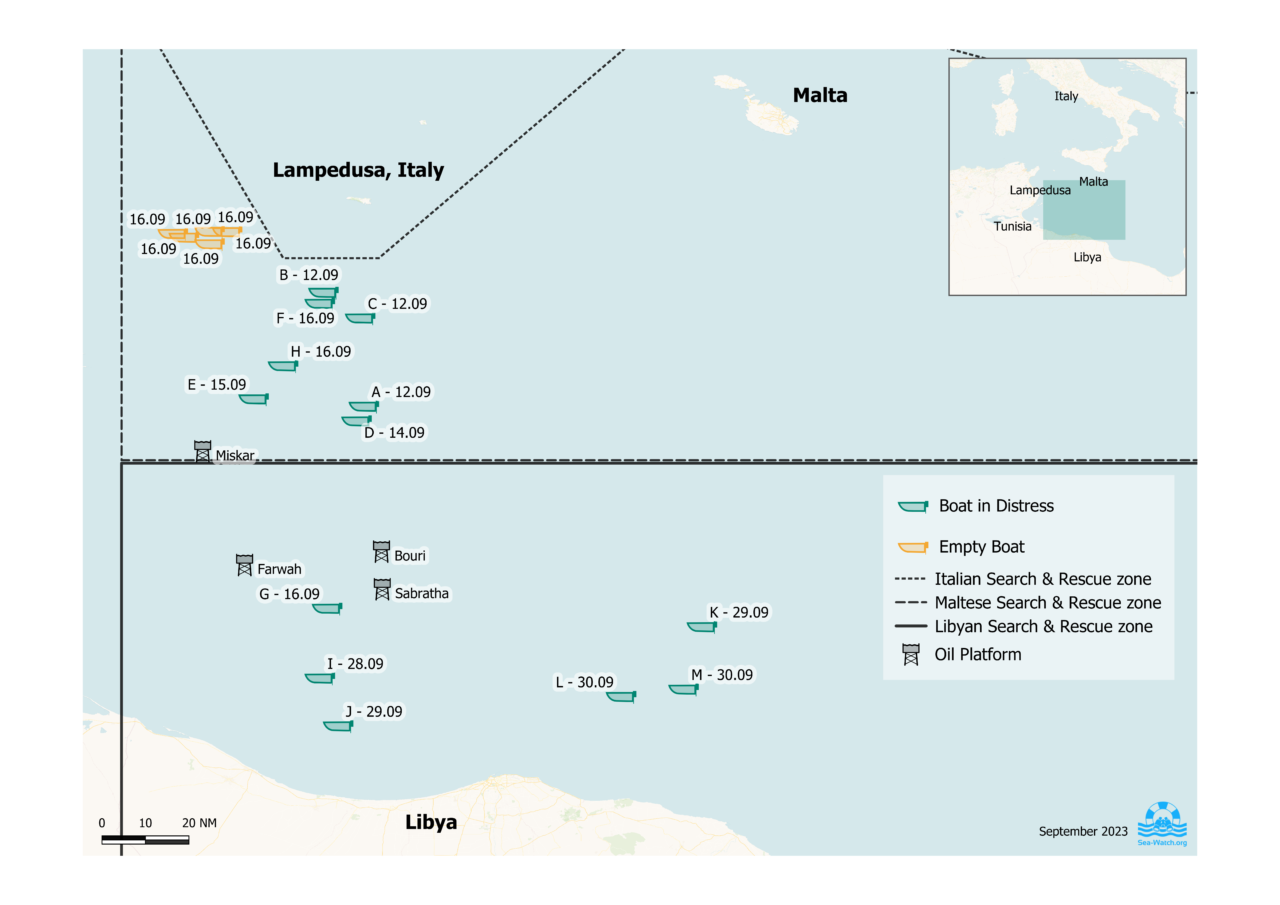
Overview of boats in distress and empty boats spotted
Libyan Search-and-Rescue (SAR) zone
- 61 persons, aboard 1 boat in distress, were rescued by the NGO vessel Geo Barents (3) and disembarked in Italy
- 107 persons, aboard 1 boat in distress, were rescued by the NGO vessel Open Arms (4) and disembarked in Italy
- Around 210 persons, aboard 3 boats in distress, were intercepted by the so-called Libyan Coast Guard and pulled back to Libya
- The outcome for 40 persons in distress, aboard 1 boat, is unknown
Maltese Search-and-Rescue (SAR) zone
- 70 persons, aboard 1 boat in distress, were rescued by the Italian authorities and disembarked in Italy
- The outcomes for around 305 persons in distress, aboard 6 boats, are unknown
In September 2023, we must assume that the European Border and Coast Guard Agency Frontex was involved in the narrative for around 70 persons, aboard 1 boat in distress sighted by Seabird 2’s crew which was eventually rescued by the Italian authorities. In September, Seabird 2’s crews sighted 5 empty boats, the outcomes for which are unknown.
Details and outcomes regarding selected boats in distress and empty boats
29.09., distress case J, around 50 persons: The so-called Libyan Coast Guard conducted a dangerous interception.
Seabird 2’s crew sighted around 50 persons in distress in the Libyan SAR zone. The so-called Libyan Coast Guard patrol boat Fezzan was in the direct vicinity and could be observed launching a RHIB (5). Seabird 2’s crew then witnessed this RHIB driving into the boat in distress, despite calls from the aircrew to stop this dangerous behaviour. The boat in distress eventually deflated, leaving all of the people in the water (6). Given the severity of the situation, Seabird 2’s crew sent out several mayday relays (7). At one point, an unidentified source asked whether the so-called Libyan Coast Guard were on-scene. When Seabird 2’s aircrew confirmed this, the unidentified source replied that there was then “no need for assistance” – an untruth since there was still a potential risk for persons or bodies to be in the water. This source then did not identify itself or respond any further to Seabird 2’s crew. The Fezzan intercepted all persons in distress and pulled them back to Libya. With Seabird 2’s crew, the NGO vessel Louise Michel looked for potential bodies but could not find any.
The so-called Libyan Coast Guard are financed, trained and equipped by the European Union and European member states: with such cooperation, European actors co-perpetrate crimes against humanity (8). We demand that the authorities of European member states and the European Union cease their cooperation with Libyan authorities – instead, they must actively engage in Search-and-Rescue operations, in compliance with the law.
29.09., distress case K, around 40 persons: An aircraft of the Armed Forces of Malta is on the scene of an interception by the so-called Libyan Coast Guard and behaves dangerously towards our aircraft.
Seabird 2’s crew sighted around 40 persons in distress in the Libyan SAR zone. The so-called Libyan Coast Guard vessel Ubari was in the vicinity and was observed heading towards the position of the persons in distress. As the Ubari started its interception, Seabird 2’s aircrew observed the Armed Forces of Malta aircraft Mission19 also on-scene. The aircraft did not clarify its position, despite several calls by Seabird 2’s crew over the radio to do so, leading to a very dangerous situation between the aircraft: according to the aircrew, the Armed Forces of Malta very closely crossed Seabird 2’s altitude.
The Maltese authorities have a Memorandum of Understanding with Libya (9). We demand that Malta stop their cooperation with Libya and instead comply with their duties: to search for and assist persons in distress at sea and ensure their disembarkation in a place of safety – which can only be Europe according to international law. The Maltese authorities furthermore must cooperate with all actors in order to ensure safety at sea.
30.09, distress case M, around 120 persons: An interception operated by an unidentified Libyan naval asset as well as a new asset provided to Libyan actors by the European Union.
Seabird 2’s crew sighted around 120 persons in the Libyan SAR zone. Two unknown, likely Libyan RHIBs were boarding the boat in distress, until the so-called Libyan Coast Guard patrol boat Ghat eventually arrived, intercepting and pulling the people back to Libya. The NGO vessel Open Arms was operational on that day and could have rescued and disembarked the persons in a place of safety.
This patrol boat was recently given to Libyan actors within the framework of the Emergency Trust Fund for Africa (10). The European Union and European member states must stop their policy of death at sea. Instead of illegally outsourcing European states’ duties to the so-called Libyan Coast Guard, authorities of European member states must comply with the law and engage in search and rescue operations.
These operations highlight once again:
- the deadly consequences of European migration and border policies
- the systematic non-assistance by European Member States and their delegation of rescue operations to the Tunisian Coast Guard, even from the Maltese SAR zone
- the unjustified and systematic delays by European Member States in fulfilling their obligations to conduct and coordinate sea rescue in their Search-and-Rescue zones
- the continuous involvement and recurring non-assistance of merchant vessels regarding boats in distress at sea due to the failed migration policies in Europe
- the need for NGO vessels in the central Mediterranean sea in order to uphold the law and save human lives
(1) Since 2017, together with the Swiss NGO Humanitarian Pilots Initiative, Sea-Watch has monitored the central Mediterranean Sea – presently with its aircraft Seabird 1 and Seabird 2.
(2)These numbers are based upon the estimations of Seabird 2’s crews as well as numbers which the initiatives Watch The Med – Alarm Phone, SAR NGOs and Mediterranean Hope-FCEI have provided to us.
(3) The Geo Barents is operated by the NGO Médecins Sans Frontières.
(4) The Open Arms is operated by the NGO Open Arms.
(5) A RHIB is a rigid hulled inflatable boat – a fast, lightweight and stable boat usually used by the military for operations at sea.
(6) Footage of the dangerous behaviour is available at: https://x.com/seawatch_intl/status/1707803433145680293?s=20
(7) A “mayday relay” is an emergency procedure that provides information about a boat in distress via maritime or aerial radio, requesting any asset in the vicinity to assist.
(8) See the ECCHR’s communication to the International Criminal Court: https://www.ecchr.eu/en/case/interceptions-of-migrants-and-refugees-at-sea/
(9) The document is available at: https://www.statewatch.org/media/documents/news/2020/jun/malta-libya-mou-immigration.pdf (10) See: https://neighbourhood-enlargement.ec.europa.eu/news/commissioner-oliver-varhelyi-attends-handover-ceremony-eu-financed-search-and-rescue-vessels-libya-2023-02-06_en

